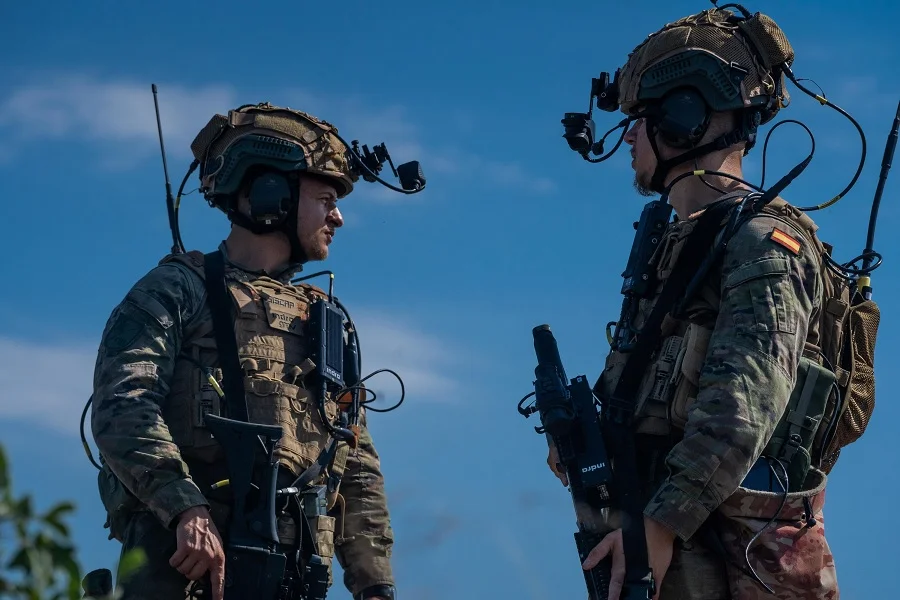Indra and GMV have taken a decisive step forward in the development of the Future Soldier System (SISCAP, in Spanish), after carrying out an operational demonstration at the Toledo Infantry Academy with this solution, which boosts the soldier’s communication, information, and fire efficiency capabilities. As a result of an R&D program funded by the Ministry of Defence through the Sub-Directorate General for Planning, Technology and Innovation (SDG PLATIN), the progress of this new development is being supervised by the Directorate General for Armaments and Material (DGAM). Indra and GMV’s aim is to equip combatants with advanced technologies for use in digitalized theaters of operations, where they will have to operate in network operations with systems adapted to the new Spanish Army combat cloud concept. Each of these soldiers will have a vision system attached to their helmet that, using augmented reality, will allow them to visualize the route to follow and the position of their companions and to receive different tactical indications about threats and identified targets. They will also have both day and night vision, personal cameras (visible and thermal) to gather images and an advanced radio that will position them by satellite and allow them to transmit voice and data, as well as setting up different groups for improved coordination.
The manager of the UTE at Indra, Gregorio González, explains that “the system will provide soldiers with the most advanced digital capabilities and will provide them with a situational awareness of the highest level, by giving them a vision capacity enriched with the information collected by all their colleagues and other deployed means” and adds that “one of the great advantages of the system is that it is modular and scalable, which allows it to be adapted to the mission being carried out, ensuring maximum ergonomics and minimum weight”. This modularity allows, for example, the addition of electronic aids to distinguish between friendly and enemy forces, infrared cameras, laser designators or image magnifiers, as appropriate, to the fire effectiveness system. In the case of more complex missions, soldiers can even be equipped with palm-sized micro-drones to reconnoiter the area and minimize risks. SISCAP’s open architecture will allow the incorporation of new functionalities in the future, such as the use of artificial intelligence for target discrimination, checking the status of combatants and facilitating system maintenance.
The assault rifle will incorporate its own viewfinders and cameras that extend the range and accuracy of fire and allow the possibility of non-line-og-sight fire, so that the image captured by the weapon’s viewfinder can also be seen in the helmet’s vision systme, thus avoiding being exposed when turning a corner or entering an enclosed area. It will also incorporate controls to handle communications without having to release the rifle or to prevent friendly fire. The platoon leader will have a tablet connected to the battlefield management system (BMS) used in the rest of the Army, thus integrating the unit into the chain of command. In a group of exercises held last month at the Toledo Infantry Academy, a platoon evaluated the system by simulating a reconnaissance mission and other day and night surveillance missions. They also conducted various day and night shooting tests. The next and final test that SISCAP will undergo in the coming months will add to this equation the presence of the 8×8 Dragon armored vehicle, which will act as a communications node between the unit and its headquarters.
Indra and GMV’s goal is to close this first development phase this year, delivering the first seven functional prototypes in platoon-leader configuration. In subsequent phases, the possibility of manufacturing an initial pre-series of 40 or 50 systems will be studied for evaluation in real operations, and then, from 2030 onwards, for larger-scale production. The work of Indra and GMV in European projects such as ACHILE and GOSSRA, funded by the European Commission, has generated significant synergies and contributed to the development of this solution. At the same time, SISCAP is part of the Army’s Force 35 initiative, which places the soldier at the center of its modernization strategy. Indra is one of the main global defence, aerospace and technology companies and a leader of the digital transformation and information technologies in Spain and Latin America through its Minsait subsidiary. Its business model is based on a comprehensive range of proprietary products with a significant innovative component, making it the technological partner for the digitalization and key operations of its clients around the world. Sustainability is an integral part of its strategy and culture in order to overcome current-day and future social and environmental challenges. In the financial year 2023, Indra achieved revenue totaling €4.343 billion, with more than 57,000 employees, a local presence in 46 countries and business operations in over 140 countries.















